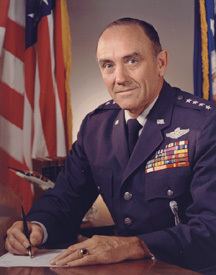Years of service 1938–1973 Name John Ryan | Battles/wars World War II Awards See below Children Michael E. Ryan | |
 | ||
Born December 10, 1915Cherokee, Iowa ( 1915-12-10 ) Allegiance United States of America Commands held Chief of Staff, U.S. Air ForceStrategic Air CommandSixteenth Air ForceSecond Air Force | ||
Service/branch United States Air Force | ||
General John Dale Ryan (December 10, 1915 – October 27, 1983) was the seventh Chief of Staff of the United States Air Force. As chief of staff of the U.S. Air Force, General Ryan served in a dual capacity. He was a member of the Joint Chiefs of Staff, which, as a body, acts as the principal military adviser to the president, the National Security Council, and the Secretary of Defense. In his other capacity, he was responsible to the Secretary of the Air Force for managing the vast human and materiel resources of the world's most powerful aerospace force.
Contents

Early life
The general was born in Cherokee, Iowa, in 1915. Following graduation from Cherokee Junior College in 1934, he entered the United States Military Academy from which he graduated in 1938. He next attended flying school at Randolph and Kelly fields, Texas, and received his pilot wings in 1939.
Military career
General Ryan remained at Kelly Field as a flight instructor for approximately two years. From January 1942 until August 1943, he was director of training at Midland Army Air Field, Texas, and was instrumental in establishing an advanced bombardier training school. His next assignment was as operations officer for the Second Air Force at Colorado Springs, Colorado In February 1944, he was transferred to Italy where he commanded the 2d Bombardment Group and later became operations officer for the 5th Bombardment Wing, Fifteenth Air Force. While commanding the 2d Bombardment Group he lost a finger to enemy antiaircraft fire. Later on, this resulted in his nickname, sometimes used derisively, "Three-fingered Jack."
He returned to the United States in April 1945, and became deputy air base commander, Midland Army Air Field, Texas. In September 1945, he was assigned to the Air Training Command at Fort Worth and Randolph Field, Texas, where he remained until April 1946, when he assumed duties with the 58th Bombardment Wing and participated in the Bikini Atoll atomic weapons tests.
From September 1946 to July 1948, he was assistant chief of staff for pilots of the 58th Bombardment Wing and then Eighth Air Force director of operations. For the next three years, he commanded the 509th Bombardment Group at Walker Air Force Base, New Mexico. Between July 1951 and June 1956, General Ryan commanded the 97th Bombardment Wing and the 810th Air Division, both at Biggs Air Force Base, Texas, and the 19th Air Division at Carswell Air Force Base, Texas.
General Ryan became director of materiel for the Strategic Air Command in June 1956, and four years later assumed command of SAC's Sixteenth Air Force in Spain. In July 1961, he was named commander of the Second Air Force at Barksdale Air Force Base, Louisiana.
In August 1963, General Ryan was assigned to the Pentagon as inspector general for the U.S. Air Force. One year later he was named vice commander in chief of Strategic Air Command and in December 1964, became commander in chief. He was assigned as commander in chief, Pacific Air Forces, in February 1967.
The general was appointed vice chief of staff of the U.S. Air Force in August 1968, and chief of staff of the U.S. Air Force in August 1969.
One of the more controversial moves of his tenure was his disbandment of the U.S. Air Force Pipes and Drums, the only free-standing, full-time pipe band in the U.S. armed forces.
Ryan's tenure as commander of PACAF and Air Force Chief of Staff also engendered controversy when he was described as one of a group that helped destroy General Jack Lavelle's career after Lavelle gave fighter pilots permission to shoot back at bona fide threats, something previously denied them by rules of engagement. This was also related to the court-martial of USAF Colonel Jack Broughton, after Broughton attempted to protect one of his pilots who shot back at an anti-aircraft position also in apparent violation of rules of engagement. The irony is that Col Broughton had to protect the pilot from his own side, and directly from General Ryan, whose "undue command influence" later resulted in the overturning and expungement of Broughton's conviction by the USAF Board for the Correction of Military Records.
Awards and decorations
Other achievements
In July 1971, General Ryan became the first foreign dignitary to receive the Golden Wings of the Philippine Air Force. Additional foreign decorations are Chilean Military Star of the Armed Forces, Class of Great Star for Military Merit
In December 1962, he joined a select group of athletes, who have been successful in their professional careers since their college football days, when he was chosen a member of the Sports Illustrated Silver Anniversary All-American team.
He received an honorary doctor of laws degree from Creighton University, Omaha, Nebraska, on May 30, 1966; and an honorary doctor of laws degree from the University of Akron, Ohio, on June 5, 1967.
General Ryan's son, General Michael E. Ryan, USAF, also held the position of Chief of Staff of the United States Air Force. Unlike the elder Ryan's career as bomber pilot, the younger Ryan was a fighter pilot.
